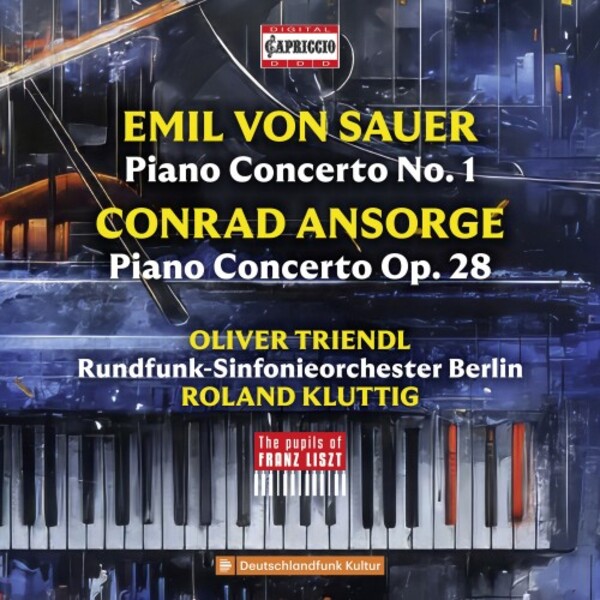ANSORGE; SAUER Piano Concertos (Oliver Triendl)
View record and artist detailsRecord and Artist Details
Genre:
Orchestral
Label: Capriccio
Magazine Review Date: 04/2025
Media Format: CD or Download
Media Runtime: 63
Mastering:
DDD
Catalogue Number: C5511

Tracks:
| Composition | Artist Credit |
|---|---|
| Concerto for Piano and Orchestra No. 1 |
Emil von Sauer, Composer
Berlin Radio Symphony Orchestra Oliver Triendl, Piano Roland Kluttig, Conductor |
| Piano Concerto |
Conrad Ansorge, Composer
Berlin Radio Symphony Orchestra Oliver Triendl, Piano Roland Kluttig, Conductor |
Author: Jeremy Nicholas
Emil Sauer (1862-1942), as he was born, was among Liszt’s most distinguished pupils, a renowned virtuoso, distinguished pedagogue and successful composer. In fact, in this last role he was rather more successful than the booklet writer credits him, having written not two but 30 concert études and not several but well over 50 other solo piano works. Most of these have been recorded superbly by Oleg Marshev (Danacord). More to the point, so have Sauer’s two piano concertos. Both are significant contributions to the literature that deserve to be standard repertoire.
Stephen Hough made the first recording of Piano Concerto No 1 back in 1994 coupled with Scharwenka’s Fourth, an unlikely pairing that won not only the 1996 Gramophone Concerto Award but was voted Recording of the Year. This new recording will win the work new friends. Oliver Triendl was born in Bavaria (1970), and we are told his ‘tireless commitment [to neglected and rarely played composers] is reflected in almost 150 CD recordings’ and that he has some 90 concertos in his repertoire. His take on the Sauer E minor bears favourable comparison with Hough’s, though the latter brings his trademark brio and attack to a more fleet-fingered first-movement Allegro patetico and is much to be preferred. The two pianists are more in accord for the other three movements (Scherzo, Cavatina and Rondo), all with powerful and memorable thematic material.
The Sauer is paired with the premiere recording of a piano concerto by another Liszt pupil, Conrad Ansorge (1862-1930), whose career was respectable but far less conspicuous than Sauer’s. I found this work difficult to get a handle on. Its three movements, written in a late-Romantic style, are said to have a programme (one which Ansorge did not, however, divulge). The booklet writer asks pertinently if it is a piano concerto or a tone poem with a piano obbligato, the impression given being ‘more of a predominantly lyrical fantasy’. I think that’s about right. The work is strewn with various quotes (mostly of Beethoven), apparently, ‘subtly interspersed, audible only to trained ears’. All this might make it sound more intriguing than it really is. All I can say is that Ansorge, on this showing, was no self-inspired melodist and my concentration wandered on first and second hearings. I salute Triendl and his colleagues for their endeavour but I don’t think we need a further recording.
Discover the world's largest classical music catalogue with Presto Music.

Gramophone Digital Club
- Digital Edition
- Digital Archive
- Reviews Database
- Full website access
From £8.75 / month
Subscribe
Gramophone Full Club
- Print Edition
- Digital Edition
- Digital Archive
- Reviews Database
- Full website access
From £11.00 / month
Subscribe
If you are a library, university or other organisation that would be interested in an institutional subscription to Gramophone please click here for further information.




